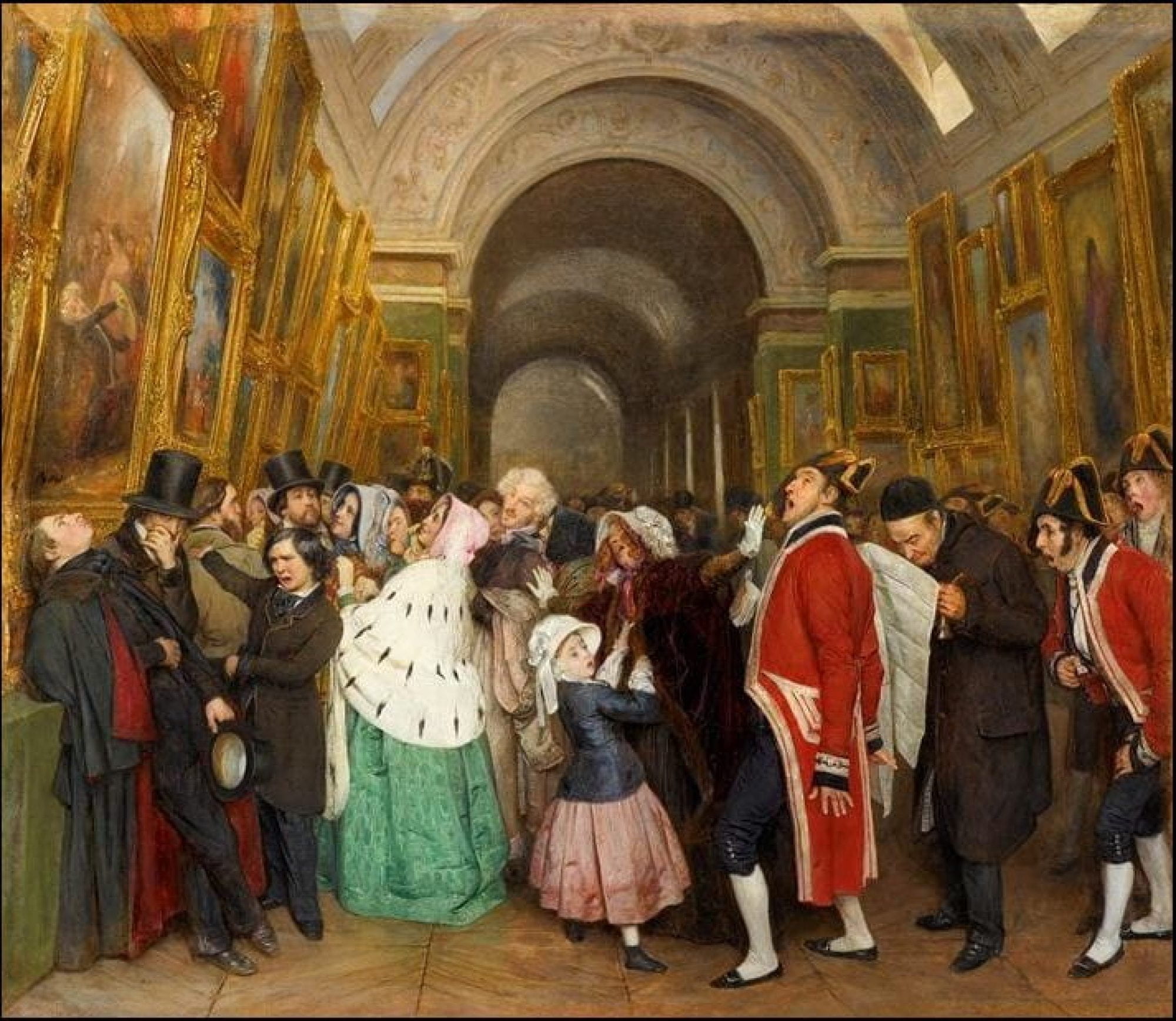Brushstrokes Through Time: A Review of Impressionism and Realism at Art on 12
Impressionism, a movement that originated in 1874, marked a departure from the traditional norms of art enforced by the Salon since the 17th century. Led by artists such as Claude Monet, Edgar Degas, and Camille Pissarro, the Impressionists were initially ridiculed for the rushed, unfinished look of their paintings, but they eventually embraced the label with pride. Art on 12, a gallery that boasts a diverse collection of artists, currently showcases an array of impressive works, including those of Jefferis, whose art is on display. However, Leigh Peterson’s art is not currently featured at the gallery. I had asked Leigh to bring in her art for me to review alongside Jefferis’, both of whose impressionistic and realism paintings respectively captivate with their vibrant colors, thick brush strokes or scrapes, and skillful use of complementary and muted tones to create depth. Art on 12 gallery provides an excellent opportunity for visitors to experience the revolutionary spirit of Impressionism and witness how it continues to inspire contemporary artists today.
As one enters Art on 12, the gallery is brimming with a multitude of artworks that adorn every room, from top to bottom, even extending to the hallways. The artworks are elegantly hung on light gray slats with sliding anchors, allowing for easy adjustments by the artists themselves. The gallery’s lighting is meticulously designed with daylight bulbs, illuminating the art with a warm or cool glow, enhancing its visual impact.
Jefferis’ collection of oil paintings, on display at Art on 12, are a testament to the beauty of natural scenery. From mountains and rivers to creeks and canyons, Jefferis masterfully captures the essence of these landscapes with his distinct impressionistic style. Paintings such as Pond Reflections, California Outcrop, Yellow Lady, Canyon de Chelly, Hanging On By a Thread, Yosemite Bluff, and St. Tropez are a testament to his artistic prowess.
 Jefferis Peterson, Pond Reflections, Oil
Jefferis Peterson, Pond Reflections, Oil
One of the striking features of Jefferis’ paintings is the incredible depth he achieves through his skillful use of color. By employing complimentary colors and muted tones, Jefferis creates a sense of distance and perspective in his landscapes. In Pond Reflections, for instance, the bold, warm colors of the midground are juxtaposed by the cool blue rim of the sky and the dark but reflective pond in the foreground, creating a sense of depth that draws the viewer into the scene. The yellow and green of the landscape dance across the wide pond, seemingly giving movement to the littoral zone. The thick strokes and scrapes of a dry palette knife give a beautiful texture to an already stunning scene. Similarly, in California Outcrop, the vibrant oranges and reds of the rocks topped with fields of green and purple shadows in the foreground gradually give way to softer blues of the never ending sky and sea, evoking a sense of distance and vastness.
 Jefferis Peterson, California Outcrop, 11×14, Oil
Jefferis Peterson, California Outcrop, 11×14, Oil
 Jefferis Peterson, Yosemite Bluff, 12×16, Oil
Jefferis Peterson, Yosemite Bluff, 12×16, Oil
Jefferis’ bold and expressive brushwork adds to the allure of his paintings. Using thick brush strokes or scrapes with a palette knife, he creates a sense of movement and energy in his works. In Yosemite Bluff, for example, the soft brushwork in the sky and water in contrast to the sharp and rough strokes of a palette knife on the bluff imbues the scene with a sense of dynamism and liveliness. Similarly, the fuzzy reflections across the water give the painting underappreciated depth. The impasto technique used in Hanging On By a Thread adds texture and tactile quality to the painting, inviting the viewer to explore the details and intricacies of the artwork. The top half of the painting, featuring a soft sky, green hill top and a flourishing tree, gives way to the rest of the painting, where you see the tree’s roots growing around a jutting rock, hanging on by a thread. The impasto technique is used on the rock face, roots and autumn foliage sloping down the limestone rock face.
 Jefferis Peterson, Hanging on by a Thread, 16×20, Oil
Jefferis Peterson, Hanging on by a Thread, 16×20, Oil
 Jefferis Peterson, Yellow Lady, Canyon de Chelly, 11×14, Oil
Jefferis Peterson, Yellow Lady, Canyon de Chelly, 11×14, Oil
In addition to his technical prowess, Jefferis’ ability to capture the essence of natural scenery, such as its light, color, texture, in order to convey its beauty, serenity, power, is truly awe-inspiring. His paintings evoke a sense of serenity and tranquility, as if the viewer is transported to the very location depicted on the canvas. In Yellow Lady, Canyon de Chelly, for instance, Jefferis captures the majestic beauty of the canyon with its towering dark purple and gray blue rock formations with the striking golden bush, inviting the viewer to immerse themselves in the splendor of the landscape. In St. Tropez, the allure of the dark sea and the coastline that is filled with tall houses with facades of ochre, yellow, or orange that are subtly reflected in the waters of the port. The empyrean appears to be brimming with an imminent deluge, as if the sky itself is on the verge of unleashing a torrential downpour. Viewing this painting transports the viewer to a moment in time when the natural world is both beautiful and dangerous, and one can’t help but feel a sense of awe and respect for the power of nature. The painting captures the approaching and enduring nature of a storm, making the experience all the more intense and memorable for the viewer. The significance of Jefferis’ paintings lies not only in their technical excellence and aesthetic appeal, but also in the emotions they evoke in the viewer.
 Jefferis Peterson, St. Tropez, 30×40, Oil
Jefferis Peterson, St. Tropez, 30×40, Oil
Leigh Peterson’s collection of realist paintings offer a striking contrast to Jefferis’ impressionistic works. While Jefferis captures the essence of natural landscapes with bold brushwork and vibrant colors, Leigh’s paintings focus on man-made structures and everyday scenes, depicting them with remarkable attention to detail and precision.
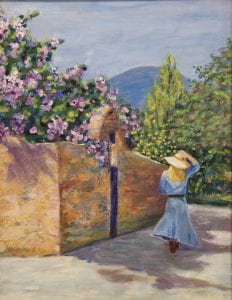 Leigh Peterson, Jenn’s Escape Day, Acrylic
Leigh Peterson, Jenn’s Escape Day, Acrylic
One of the notable aspects of Leigh’s paintings is her ability to capture the beauty in everyday scenery. Whether it’s a house by a river, an open sky, or an old building. In fact, one of Leigh’s first paintings, Jenn’s Escape Day, reveals the hidden charm in ordinary scenes that often go unnoticed. Her keen eye for detail is evident in her painting of the garden scenery, where she skillfully portrays the multicolored plaster of stone on the ground with faint pinks and blues, creating a sense of texture and depth. The blonde woman in a blue dress, holding her harvest hat and wearing brown boots, becomes the focal point of the painting as she walks along the path. The warm orange wall with purple shadows cast by the tree in the background adds a sense of warmth and tranquility to the scene. One of Leigh’s distinct approaches in her realist paintings is her depiction of people from behind. This perspective adds an element of mystery and intrigue to her works, as the viewer is left to wonder about the stories and emotions of the people in the scene. Leigh’s attention to detail is evident in her portrayal of the figures, capturing their posture, clothing, and gestures with remarkable accuracy.
Leigh’s skillful use of color is another notable feature of her paintings. She carefully selects and applies colors to create a harmonious and visually appealing composition. In a painting titled, When the World is at Peace, Leigh uses a muted palette of whites, grays, and blues along with warm yellows and browns to convey the serenity and peacefulness of a winter landscape turning into spring. Her meticulous attention to detail in capturing the subtle variations in light and shadow on the snow-covered ground and trees adds a sense of realism and depth to her paintings.
 Leigh Peterson, Cabin, Acrylic
Leigh Peterson, Cabin, Acrylic
In Cabin by Leigh Peterson, the focal point is an old cabin with a rusted metal panel roof. The roof is depicted with grayish blues, dull browns, and rusted orange hues, suggesting its weathered condition. The foreground features a lush field of grass in arylide yellow and luxor gold, creating a vibrant contrast to the cabin. The grass is rendered with small tufts of native tall grass, adding a sense of age to the scene. The cabin is partially obscured by a tree on the right side of the painting, adding a sense of depth and dimension to the composition. In the background of the Cabin, tall dark green leaves, presumably from live oak trees, fill the sky behind the cabin. The leaves cast a cool blue shadow on the cabin, creating a beautiful interplay of light and shadow. The way the leaves dance across the front of the cabin adds a dynamic and lively quality to the scene, bringing the painting to life.
On the other hand, Yellow Lady by Leigh Peterson, which is also a painting in which she and Jefferis both painted the same subject matter on separate canvases, showcases Leigh’s attention to detail, colors, and her inclination towards realism. Similar to Jefferis’ Yellow Lady, Canyon de Chelly, Leigh captures the majestic beauty of the canyon with its towering dark purple and gray-blue rock formations, contrasting against the striking golden bush. However, in Leigh’s painting, she incorporates more greenery, adding a sense of lushness and vibrancy to the landscape.
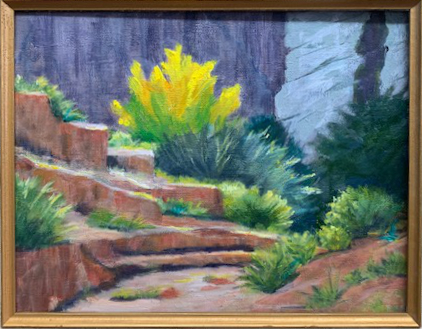 Leigh Peterson, Yellow Lady, Acrylic
Leigh Peterson, Yellow Lady, Acrylic
Leigh’s Yellow Lady also features a wider range of appreciable hues, with less intense colors compared to Jefferis’ version. The colors used in Leigh’s painting are more subdued, creating a softer, muted and rather reflective overall effect. The landscape is depicted with burnt orange Martian-esque terrain, providing a strong contrast between the foreground, midground and background. The vegetation that flourishes across the landscape adds a sense of vitality and life, providing an interesting contrast to the rocky formations.
Leigh’s paintings also showcase her technical skill and expertise in the realist style. Her precise brushwork and meticulous attention to detail result in paintings that are almost photographic in their realism. Her ability to capture the play of light and shadow, the textures of different surfaces, and the subtle nuances of color demonstrate her experience of the realist technique. Leigh Peterson’s realist paintings offer a compelling contrast to Jefferis’ impressionistic works. Her keen eye for detail, skillful use of color, and meticulous attention to detail make her paintings captivating. Through her depictions of everyday scenery and her technical expertise in the realist style, Leigh’s paintings invite viewers to appreciate the beauty in the ordinary and see the world through her unique perspective.
 Close up of Jefferis Peterson’s Yellow Lady, Canyon de Chelly
Close up of Jefferis Peterson’s Yellow Lady, Canyon de Chelly
Jefferis’ impressionistic works transport viewers to breathtaking landscapes with their bold brushwork, vibrant colors, and skillful use of depth and perspective. Leigh’s realist paintings, on the other hand, focus on the beauty of everyday scenes, depicted with remarkable attention to detail, precise brushwork, and an ability to capture mood and atmosphere. Both artists’ paintings evoke emotions, whether it be the sense of awe and wonder in Jefferis’ landscapes or the nostalgia and appreciation for the ordinary in Leigh’s everyday scenes. Despite working on separate canvases, Jefferis and Leigh Peterson’s paintings often complement and contrast each other. It is interesting to note that the artists sometimes use the same source material, yet interpret it in their unique styles. This provided me with a fascinating opportunity to observe how two artists can approach the same subject matter in vastly different ways, yet still evoke similar emotions in the audience. The juxtaposition of their works during my visit allowed for a deeper appreciation of both Impressionism and Realism and how they can be used to convey emotions and stories.
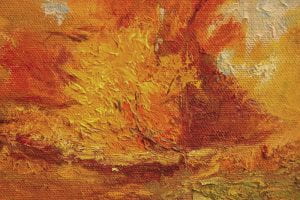 Close up of Jefferis Peterson’s Golden Pond Reflections
Close up of Jefferis Peterson’s Golden Pond Reflections
Art on 12 provides a captivating venue for artists to showcase their talents, with elegantly hung displays, meticulously designed lighting, and an overall welcoming ambiance. The gallery serves as a celebration of the enduring appeal of Impressionism and Realism as art movements that continue to inspire and captivate audiences today, even after more than a century has passed since their inception. These art movements continue to be relevant because of their ability to capture fleeting moments in time and the essence of everyday life. Rather than being about nostalgia for the past, Impressionism and Realism reveal the human experience in a way that is both timeless and yet intimately connected to our shared humanity. The art on display at Art on 12 reminds us of the ability of art to transport us, evoke emotions, and enrich our lives, and serves as a testament to the enduring legacy of these art movements. Whether one is a seasoned art enthusiast or a casual observer, this Texas destination gallery offers a feast for the eyes and a thought-provoking experience that is not to be missed by anyone who appreciates the beauty and power of art.
—
 Follow Jefferis on Instagram: @jefferisp7
Follow Jefferis on Instagram: @jefferisp7
Visit Jefferis’ website: jefferis.gallery
Explore Art on 12’s website: arton12.com
Check out Art on 12 in person at: 13811 Ranch Rd 12, Wimberley, TX 78676
—
After spending time admiring Jefferis’ stunning collection of oil paintings, I couldn’t resist purchasing two of his works from Art on 12. Valley Cabin and Pond Reflections now hang proudly in my home, reminding me daily of the beauty of natural scenery and the importance of working towards a cleaner, vibrant future.
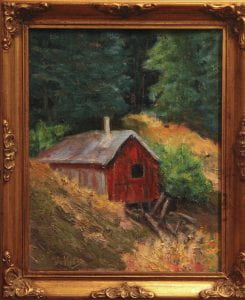 Jefferis Peterson, Valley Cabin, Oil
Jefferis Peterson, Valley Cabin, Oil
 Jefferis Peterson, Pond Reflections, Oil
Jefferis Peterson, Pond Reflections, Oil
